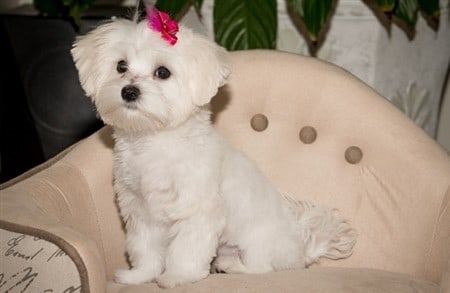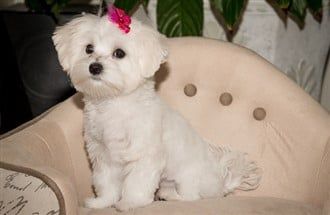Should I Get a Maltese?
Pros and Cons of this Adorable Toy Sized Breed
-min-330x296-960w.jpg)
Spunky, photo courtesy of Eldri
When you are thinking about bringing a puppy into your home, deciding which breed to choose is not an easy decision.
Those who have not owned a Maltese before wonder, 'Should I get a Maltese?' and 'Is a Maltese a good dog?'.... It's perfectly fine to question these things, because bringing a pet home means adding a member to your family. This should not be taken lightly.
Deciding on the right breed must go far beyond simply choosing a cute dog; You will want to know that a Maltese will fit well into your household and that you are able to provide the type of care that this breed requires.
We are here to help you learn all about this breed, including Maltese behavior, appearance, what you can expect in regard to grooming, feeding, and much more.
After you read this section, you may wish to take a look around at the other pages of information that we have for you.
It is our hope that anyone who answers 'Yes' to the question of getting a Maltese, will only do so after they learn about this breed and know that they are making the right choice.
Appearance
Having a Maltese is similar to having other small toys dogs such as the Pomeranian (4 to 7 lbs.), the Chihuahua (2 to 6 lbs.), and the Papillon (8 to 10 lbs.).
There are pros and cons to having such a tiny dog:
Pros: Is great for small apartments, does not require a large yard, cost of feeding is quite low even with high quality dog food, it is easy to bring a Maltese with you to run errands, etc. especially if you keep him in a carry sling.
Walking a Maltese twice per day is rather easy as well (since a brisk pace for a Maltese will not take you very far when compared to a brisk pace for a larger dog).
Cons:
Injury and trauma is a concern, care must be taken to not accidentally step on a Maltese, and a fall can be quite devastating. This is not the best breed for homes with rambunctious toddlers; close supervision and teaching proper handling techniques will need to be done.
This is not the type of breed that can go hiking up trails with you or running alongside you. But, he'll be happy to trot along as best he can, and be carried the rest of the way.
Cubbie, photo courtesy of Amy Jo
Coat Type:
The Maltese has a single coat of hair (not fur). Having a dog with a coat of this texture has some advantages and disadvantages.
Pros:
Shedding is very minimal. It is a myth that breeds with hair do not shed, because all dogs do. However, hair re-growth cycles are much less noticeable with the Maltese than other breeds with thick coats of fur that have seasonal shedding cycles.
Additionally, the single coat of hair means that any allergies
that you may have with dogs may be less severe; however, do keep in mind that there is no such thing as a 100% hypo-allergenic dog. This is because many people are allergic to the proteins found in a dog's saliva, and this is present whether you are talking about a Maltese or a Chow-Chow.
Another thing to keep in mind is that pet allergies may be to dander as well; Dander is found on dogs with hair, just often in less quantities.
Finally, a great bonus to having a Maltese is that he is a breed that can have a range of different hair styles. Options are limited with many other breeds either due to fur not being able to grow long or close shaves damaging the coat. Not so with the Maltese breed that can easily go from a long show coat to a short puppy coat, or even a close shave, but then grow the coat back again.
Cons:
Due to the silky, one-layer coat, many Maltese tend to get chilled quite easily. This is often quickly rectified by placing a cute shirt, vest, sweater or other clothing on the dog.
Skin issues are also not uncommon with this breed due in part to a coat that offers minimal protection, with dry skin being the most common skin problem. This can be rectified by using high quality shampoos
and coat products, and taking steps such as adding humidity to the house in the wintertime.
Bella, photo courtesy of The Maldonado Family
Coat Color
The Maltese is most often found with solid white coats; though, small touches of lemon or light tan may appear on the ears (permissible in the AKC show ring). This sort of coat is wonderful in many ways, but also presents its challenges.
Pros:
Solid white coats are a sought-after color for dogs. With other breeds that can be found in a range of colors, often solid whites are rare and can bring about higher pricing.
In addition, with many other breeds the coat color can change as the pup matures. But, with the Maltese, you'll always know that you'll have a solid white dog.
Cons: Dogs with white coats need proper upkeep for the white to stay white. Such things as urine and everyday debris from outside can stain the coat. Tear stains (rust color stains around the eyes) are common. And, poor bathing products can remove the shine.
You will need put thought into what you use for shampoos and coat products, and take steps to remove tear stains. Since most dogs require a certain amount of grooming time at any rate, this is not a huge con, but just something to be aware of.
Daisy, photo courtesy of The Muller Family
Other Factors to Consider if You are Thinking of Getting a Maltese
If you are still not sure of what type of dog to get, there are plenty of more reasons why the Maltese is the perfect pet:
1)
This breed is a wonderful canine family member with a great personality. He is typically very active, playful, and happy. Though he can be a bit shy, unlike some other toys that tend to become very nervous in new situations, Maltese dogs are fairly easy going and generally very content as long as they are with their owner.
2)
Maltese dogs like to be in the middle of the action and right by their humans. A Maltese makes a great companion for a single person who wants a close comrade or a family that has plenty of time to pay attention to, train, and engage in activities with the puppy or dog.
3) The life span of a Maltese
is relatively long compared to some other breeds. With good care, Maltese generally live 12 to 15 years.

-min-450x169-480w.jpg)
-min-450x247-960w.jpg)
-min-330x181-960w.jpg)






